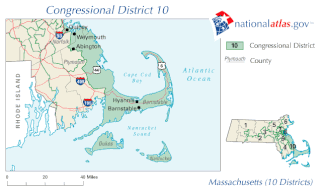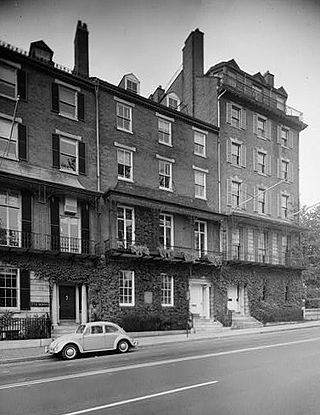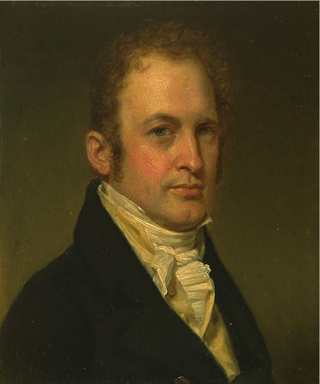
Massachusetts's 8th congressional district is located in eastern Massachusetts, including part of Boston. It is represented by Democrat Stephen Lynch. For one congressional term (1791–1793), it served as the home district of the District of Maine. The district boundaries were significantly changed, as of the elections of 2012, due to redistricting after the 2010 census, with the old 8th district largely being shifted to the new 7th district. The new 8th district comprises many of the communities of the old 9th district, as well as some easternmost Norfolk County communities and northernmost Plymouth County communities of the old 10th district.

Massachusetts's 11th congressional district is an obsolete district that was active during three periods: 1795–1843, 1853–1863, and 1873–1993. The district was located in several different areas of the state. It was most recently eliminated in 1993 after the 1990 U.S. census. Its last congressman was Brian J. Donnelly.

Massachusetts's 10th congressional district is an obsolete district that was active during 1795–2013. It was first located in the District of Maine during 1795–1803, then located in several different areas of Massachusetts. It was most recently eliminated in 2013 as district lines were redrawn to accommodate the loss of the seat due to reapportionment as a result of the 2010 census.
Walter Muir Whitehill was an American writer, historian, medievalist, preservationist, and the Director and Librarian of the Boston Athenaeum from 1946 to 1973. He was also editor for publications of the Colonial Society of Massachusetts from 1946 to 1978. From 1951 to 1972, Whitehill was a professor at Harvard University.

The Massachusetts Historical Society (MHS) is a major historical archive specializing in early American, Massachusetts, and New England history. The Massachusetts Historical Society was established in 1791 and is located at 1154 Boylston Street in Boston, Massachusetts, and is the oldest historical society in the United States.

The Peabody Museum of Salem (1915–1992), formerly the Peabody Academy of Science (1865–1915), was a museum and antiquarian society based in Salem, Massachusetts. The academy was organized in part as a successor to the East India Marine Society, which had become moribund but held a large collection of maritime materials in a museum collection at the East India Marine Hall, built in 1825 on Essex Street. The Peabody Museum was merged with the Essex Institute to form the Peabody Essex Museum in 1992. The East India Marine Hall, now embedded within the latter's modern structure, was designated a National Historic Landmark in 1965 in recognition of this heritage, which represents the nation's oldest continuously-operating museum collection.

The East India Marine Society of Salem, Massachusetts, United States, was "composed of persons who have actually navigated the seas beyond the Cape of Good Hope or Cape Horn, as masters or supercargoes of vessels belonging to Salem." It functioned as a charitable and educational organization, and maintained a library and museum. It flourished especially in the 1800s–1830s, a heyday of foreign trade.

The Bostonian Society was a non-profit organization that was founded in 1881 for the purpose of preventing the Old State House from being "moved brick by brick" from Boston, Massachusetts to Chicago, Illinois. Determined to save the historic building that was the site of the Boston Massacre and the place for the proclamation of the Declaration of Independence in Massachusetts, a group of citizens banded together to form "Boston's first successful historic preservation movement". The Bostonian Society no longer exists as a separate entity; on January 1, 2020, it merged with the Old South Association in Boston to form Revolutionary Spaces.

Cornelius Coolidge was a real estate developer in early 19th-century Boston, Massachusetts, who constructed buildings in Boston's Beacon Hill neighborhood, and elsewhere. As a young man he had been involved in maritime trade, but not always within the prescribed laws. During the War of 1812, the brig Dispatch owned by Coolidge and Francis Oliver was captured outside Boston Harbor by the Salem privateer Castigator on suspicion of trading with the enemy. Coolidge and Oliver operated two boats with 45 armed men, rowed down the harbor, and regained their brig after an exchange of gunfire. However, the district court restored the brig to the privateers.

The Boston Museum (1841–1903), also called the Boston Museum and Gallery of Fine Arts, was a theatre, wax museum, natural history museum, zoo, and art museum in 19th-century Boston, Massachusetts. Moses Kimball established the enterprise in 1841.

Ethan Allen Greenwood (1779–1856) was an American lawyer, portrait painter, and entrepreneurial museum proprietor in Boston, Massachusetts, in the early 19th century. He established the New England Museum in 1818.
The Boston Marine Society is a charitable organization in Boston, Massachusetts, formed "to 'make navigation more safe' and to relieve members and their families in poverty or other 'adverse accidents in life.'" Membership generally consists of current and former ship captains. The society provides financial support to members and their families in times of need; and also actively advises on maritime navigational safety such as the placement of lighthouses and buoys, and selection of Boston Harbor pilots.

Merchants Row in Boston, Massachusetts, is a short street extending from State Street to Faneuil Hall Square in the Financial District. Since the 17th century, it has been a place of commercial activity. It sits close to Long Wharf and Dock Square, hubs of shipping and trade through the 19th century. Portions of the street were formerly known as Swing-Bridge Lane, Fish Lane, and Roebuck Passage.
William Pierce Stubbs (1842–1909) or W.P. Stubbs was a marine painter in the Boston, Massachusetts, area in the 19th century. Examples of his work are in the Bostonian Society; Cape Ann Museum; and Peabody Essex Museum. He also lived in Bucksport, Maine.

The Samuel Eliot Morison bibliography contains a list of books and articles written by American historian Samuel Eliot Morison.
The following is a timeline of the history of Nantucket, Massachusetts, USA.
The following is a list of works about Boston, Massachusetts.

William Coolidge Lane was an American librarian and historian. He served for over 45 years in the Harvard Library at Harvard University in Cambridge, Massachusetts.

Thomas Jefferson Coolidge was a U.S. ambassador and a leading Boston businessman.
Elvira Wood was an American paleontologist who specialized in invertebrate paleontology.












